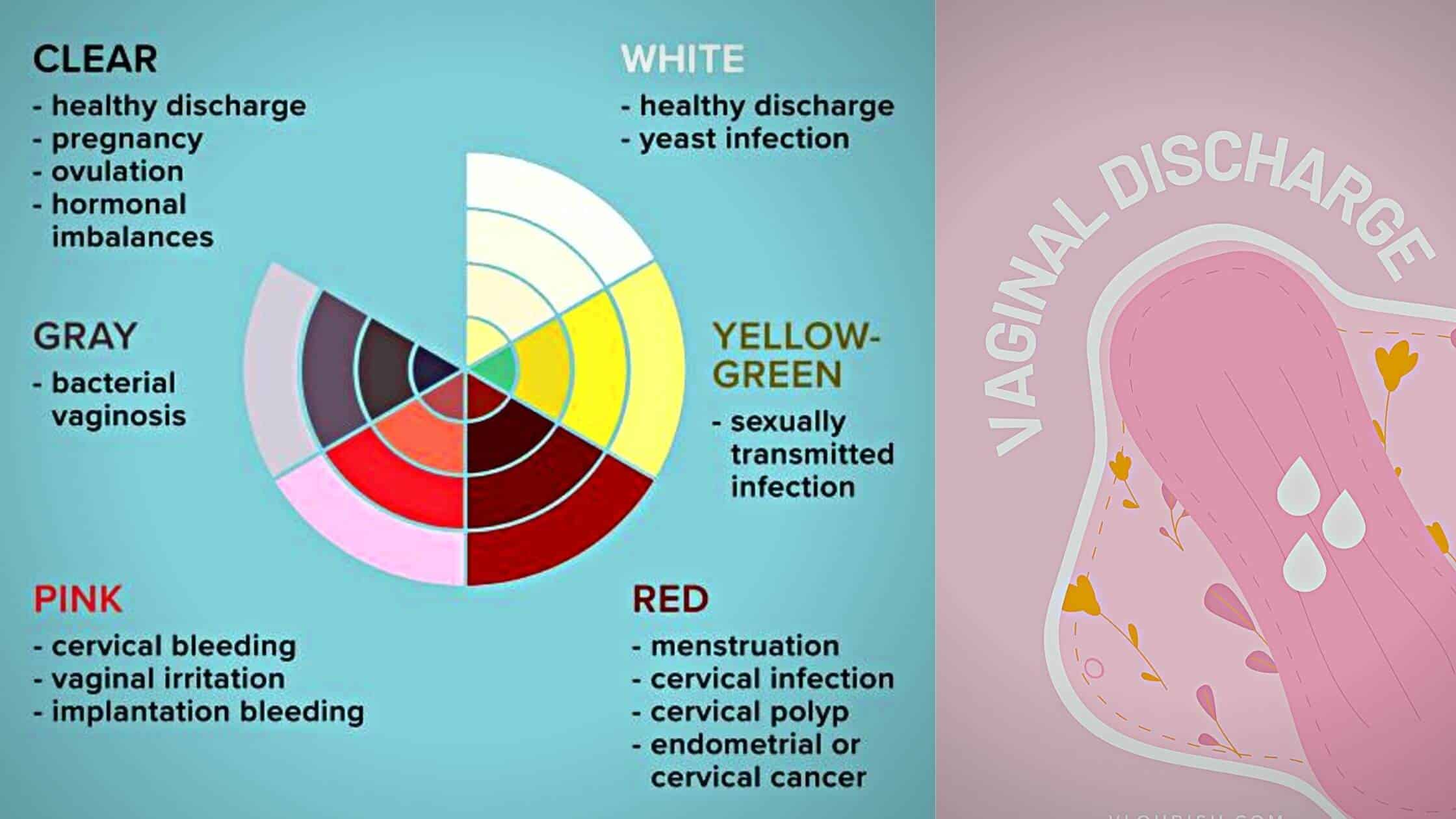Vaginal discharge is very common. There is nothing to worry about it as it is a part of the menstrual cycle. Here are a few things that you should know about vaginal discharge such as its causes, types, and indications for different colors and textures.
Normally a vaginal discharge is the secretion of the cervix which occurs as part of the ovulation process. Changes in the texture and color of the discharge can be a clue for a health problem.
Normally, it can be clear or shades of white. Vaginal discharge is part of the protective mechanism of the human body as it cleans the vagina and prevents infection.
Different Colors Of Discharge?
The color of vaginal discharge can be an indication of the underlying cause of the discharge. As normal color is white, off-white, or clear, any difference may have a reason behind it.

- Yellow: Yellow discharge can be due to a bacterial infection. Sexually transmitted Infections may also cause yellow discharge.
- Green: Green-colored discharge can be a sign of severe infection which needs to be consulted and treated properly.
- Gray: Gray-colored discharge can be due to an infection – a bacterial infection or STI.
- Pink: Pink discharge is common during the last few days of your menstrual cycle as you are approaching periods. Abnormal quantity can be an indication of pregnancy. If you are regularly seeing pink discharge for months, you have to consult a doctor as it can be due to cervix inflammation or cancer.
- Brown or any shades of red: Brown or any shades of red show the presence of blood. It can be part of your irregular menstruation. Hormonal imbalance and the use of contraceptives can be the cause of it.
What Is Normal Vaginal Discharge?
Normal vaginal discharge is white, clear, or off-white. Green, yellow, brown, or green can be due to an infection or a health problem. Even though the thickness can be different in different phases of your menstrual cycle, the maximum consistency is as of an egg white.
It will not smell bad at any stage of the menstrual cycle. It can be watery, sticky, syrupy, thick and at times pasty. Different hormones are used are playing behind the color and texture of vaginal discharges. If the discharge is too thick, it is not normal.
It can be a sign that your body is giving you a health disorder. Vaginal discharge is not odorless. The odor is not unpleasant or pungent. If you notice a foul smell, there will be a change in color and texture as it is due to an infection.
The amount of vaginal discharge can be different from person to person. Pregnancy and the use of contraceptives can be a reason for the increased amount of vaginal discharge. If you notice a change in the quantity, it should be monitored.
Once you notice a difference in the color, texture, smell, or amount of vaginal discharge, you should be very particular with personal hygiene. It is advised to change undergarments twice or thrice a day. It is also suggested to keep you hydrated to prevent the infection to go severe.
What Causes A Yellow Vaginal Discharge?
Yellow-colored vaginal discharge is an indication of infection. It can be because of an infection in the cervix gland, uterus, or urethra. As off-white secretion can be part of your menstrual cycle, see it is necessary to identify the color of the discharge before jumping to a conclusion.

- Sexually transmitted infections: Yellow discharge with a foul smell is the common symptom of sexually transmitted infections.
- Bacterial infections: If you have a bacterial infection, you will be having yellow discharge. It’s common for pregnant women and needs to be treated in time, or it will lead to complications. Itching or rashes in the vaginal face can also be seen here.
- Trichomoniasis: Trichomoniasis is a sexual disease that may spread due to intercourse with an infected person. The greenish-yellow foam-like discharge will also cause itching.
- Gonorrhea: Gonorrhea is another sexually transmitted disease that will lead to complications if left untreated. This smelly discharge will be accompanied by pelvic pain, frequent and painful urination, and vaginal bleeding.
More From Powdersville Post:
🔵 The Teen’s Parents Say She Was Denied A Kidney Transplant Because She Wasn’t Covid-Vaccinated
🔵 State-Level Non-Fatal Opioid Overdoses: The White House Releases A New Data Map
Consistency Of Vaginal Discharge
The expected consistency of vaginal discharge is watery to that of an egg white. It can be different in the different stages of your menstrual cycle.
- Egg white: Vaginal discharge can be similar to egg white during the ovulation process. It can be a bit thicker and more mucus-like during the days before menstruation.
- Milky white: The milky white with an egg white consistency is common during the first days of the menstrual cycle. This milky white discharge for prolonged days can be a sign that you are conceiving. It can be to the hormonal changes that your body undergoes during the first two months of pregnancy.
- Thick sticky discharge: The thick sticky discharge is abnormal during the last stage of your menstrual cycle. It is a bodily mechanism for preventing sperm to get point of the body.
- Sticky and from like discharge: Sticky and foamy discharge can be a sign of an infection.
When To Consult A Doctor?
Consult your doctor if you notice the following symptoms or changes in the vaginal discharge.
- A sudden increase in the amount of discharge.
- The difference in the color of discharge along with foul smell and thick or foamy texture.
- Painful sex.
- Pungent or foul odor.
- Vaginal pain or irritation.
- Frequent or painful urination.
Reference:
🔵 National Library of Medicine (n.d) VAGINAL DISCHARGE SYNDROME Available [Online] at: https://www.ncbi.nlm.nih.gov/books/NBK572663/
Teresa Breaux is a renowned health practitioner who serves as a social worker. She expertized in treating eating disorders and focuses mainly on family-based treatments. Apart from working as a health practitioner, she even provides public awareness through her writings and blogs. Her content includes methods by which you can make delicious and healthy recipes. She is so passionate about writing, especially on issues with eating habits and the importance of eating healthy. If you are someone who loves healthy tips to make your life better, then you must have run across her blogs. You can visit her website and even follow her on social media platforms like Twitter and Instagram.
